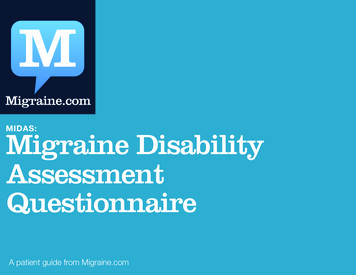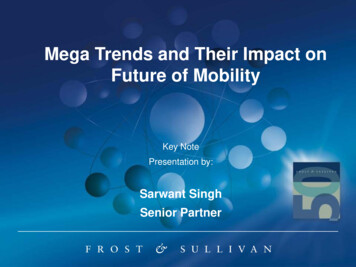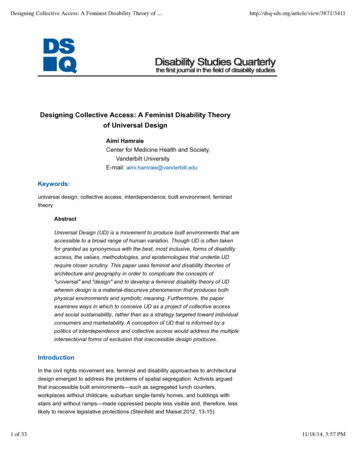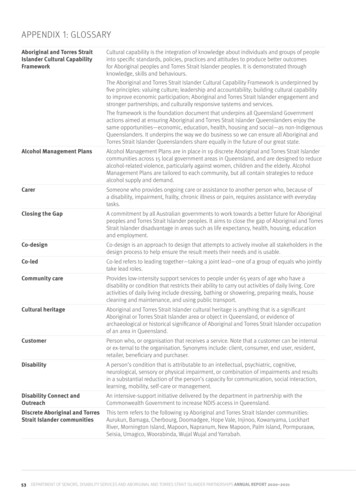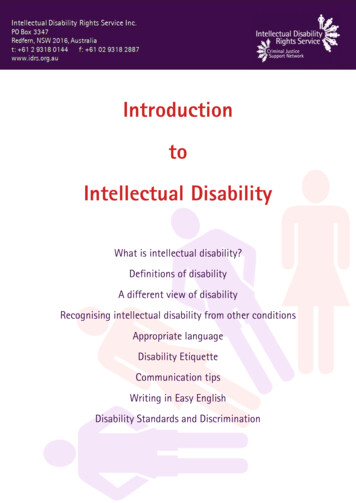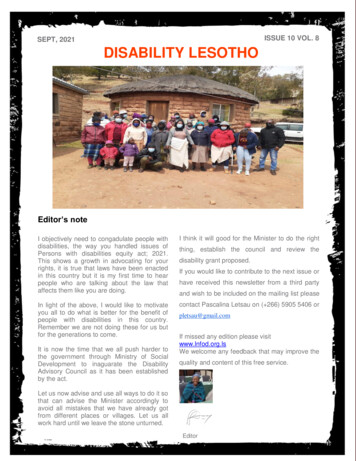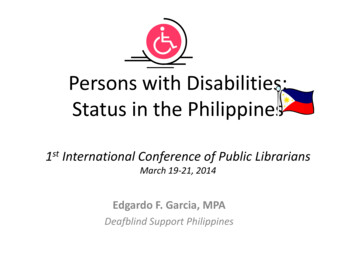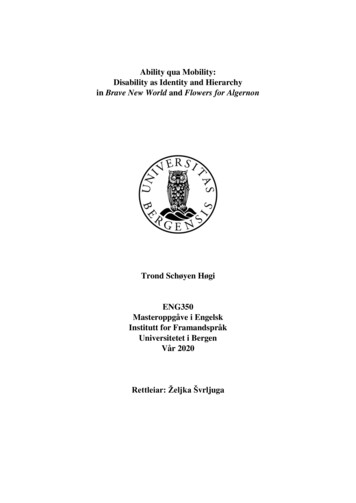
Transcription
Ability qua Mobility:Disability as Identity and Hierarchyin Brave New World and Flowers for AlgernonTrond Schøyen HøgiENG350Masteroppgåve i EngelskInstitutt for FramandspråkUniversitetet i BergenVår 2020Rettleiar: Željka Švrljuga
AcknowledgementsThe academicsI would like to thank my supervisor, Željka Švrljuga, for her patience, encouragement and forholding me to my word(s). Without her judo grip on the English language, this thesis wouldbe twice the length with half the content.Simon Bjarneson Venjum has been an invaluable ally. He helped me tease out the intricaciesof my argument and structure it to make a lick of sense.Thanks to Leonie J Campbell, Daniel Abbott and Daniel Buck for proofreading and to themany others I pestered about syntactic tomfoolery.The householdMy dear Marianne Bremdal Ekker, who provided tea and sanity when the words would notcome. Thank you.My thanks to Hege Uglum Vedvik, flatmate supreme, who never complained despite thestrange ululations she must have heard from the writing room.The familyThanks to Magnus Gallefoss, my brother from another mother, who inspired this thesis.And finally, my warmest thanks to my family, for supporting me in my strange adventuresand to my parents, for teaching me to treat people kindly, no matter how they were born.i
SamandragSkildringa av funksjonshemjing i litteraturen er ein verdifull målestokk for deisamfunnsverdiane som eit samfunn forventar både av kropp og sinn. Science Fiction inviterersærskild ei lesing med fokus på funksjonshemjing sidan genren både skildrar forventninganefrå den kulturelle samtida, og kva funksjonar ein kultur bør eller ikkje bør forvente fråinnbyggjarane sine i framtida. Daniel Keyes sin roman Flowers for Algernon (1966) skildrarCharlie Gordon, som går frå kognitivt funksjonshemma til geni og tilbake. Det er ein Hugopris-vinnande klassikar som er «ein av dei vidast lesne som tek for seg dei mentaltfunksjonshemma» og er hylla som ein humanistisk tekst.1 Aldous Huxley sin banebrytandeFagre Nye Verda (Brave New World) (1932) skildrar ei dystopisk framtid medprøverøyrsfødsel og funksjon-segregering som er tilsynelatande mindre humanistisk. Den erein vidt brukt allegori i bio-etiske diskursar, for eksempel med omsyn til testing av fostervatn.Begge romanane brukar funksjonshemjing til å konstruera dei sosiale hierarkia sine ogframkalle patos i forteljinga og karakterane. Desse hierarkia avslører ein evaluering av deiintellektuelt funksjonshemma, der dei har mindre nytteverdi enn dei som er fysiskfunksjonshemma. Denne oppgåva nyttar den teoretiske korpusen kring funksjonshemjing isamanlikninga av desse to romanane og analyserer korleis tekstane konstruererfunksjonshemjing og fordelar nytteverdi til dei funksjonshemma karakterane. Der Flowers forAlgernon presenterer teknologi som kur for funksjonshemjing, med konsekvens at einidentifiserer funksjonshemjing som verdiløyse, har Fagre Nye Verda fordelt nytteverdi til alleborgarar, uavhengig av nivået til evnene deira. Ved å setje romanane i dialog med kvarandresyner eg nødvendigheita i å skildre dei funksjonshemma som elementære medlemmar avframtidige samfunn for å fostre god diskurs.Brent Walter Cline, “‘You're Not the Same Kind of Human Being‘: The Evolution of Pity to Horror in DanielKeyes's Flowers for Algernon,” Disability Studies Quarterly 20, no. 4 (2012): 1. (My translation.)1ii
Table of ContentsAcknowledgements . iSamandrag . iiTable of Contents . iiiIntroduction . 1Established Former Readings . 4Plato and the Disability Timeline . 9Chapter 1: (Dis)ability as Hierarchy in Brave New World and Flowers for Algernon . 15(Dis)ability as Hierarchy – “All men are physio-chemically equal” . 18(Dis)ability Measures Use Value . 23Physical versus Mental (Dis)ability Stigma . 27Platonic Hierarchies in Brave New World and Flowers for Algernon . 32Plato, Huxley and Eugenics . 36Changeable Abilities Complicate (Dis)ability Hierarchies . 39Ageism Supersedes Ableism . 42Infantilization. 44Chapter Conclusion . 46Chapter 2: (Dis)ability Experienced in Brave New World and Flowers for Algernon . 49Experience of Disability – “I am I, and I wish I wasn’t” . 52Experience of Disability – “Exceptional refers to both ends of the spectrum” . 58“Its good to have frends” in Plato’s cave – Pity and Ignorance . 63Lower Caste Dialogue . 75Chapter Conclusion . 79Conclusion . 81Science Fiction and (Dis)ability Construction. 81The (Dis)ability Conversation . 85Brave New Questions, Further Research and Thesis Conclusion . 88Works Cited . 93iii
IntroductionDisability is a valuable part of human experience, yet it often impacts the individual’sperception of their own identity. Everybody identifies as more than their disability, but societymakes shortcuts by way of their definitions. In literature, identity and disability are constructsthat require constant revision. Aldous Huxley and Daniel Keyes address contemporarysocietal and individual aspects of disability through science fiction, but their novels alsoprovide a plan for how disability may be constructed in the future. Brave New World,published in 1932, is Aldous Huxley’s seminal work. It depicts the World State, a futuristicsociety of disability castes where everybody is the result of careful ectogenesis andconditioning.2 At first glance it would not compare well with Daniel Keyes’s Flowers forAlgernon, due to the latter’s temporal setting around its 1966 publication. The protagonist ofKeyes’s novel is an intellectually disabled man who undergoes an experiment to augment hisintelligence. While Keyes’s novel immediately invites a disability reading due to itsindividualistic approach to disability, Huxley’s disabled castes have not received muchscholarly attention beyond comparisons to the working classes. However, both novelsconstruct disability by drawing on Platonic imagery. This thesis examines the novels’constructions of disability in light of Plato’s to revise established former readings. Bycomparing the two novels, I argue that disabled people are indispensable to Huxley’sutilitarian world, while unexpectedly inconsequential in Keyes’s humanist approach.This thesis builds on Rosalyn Benjamin Darling’s work in Disability and Identity, andthus uses the term disability as defined by the Americans with Disabilities Act: “a physical ormental impairment that substantially limits one or more of the major life activities of such2Ectogenesis is gestation and birth in an artificial environment, outside the body.1
individual; a record of such an impairment; being regarded as having such an impairment.”3Science fiction’s role in the construction of disability should not be underestimated.4 In theabstract to their “Science Fiction and the medical humanities,” Gavin Miller and AnnaMcFarlane extol “Science Fiction’s critical relationship to the construction of ‘the future’ inthe present.”5 SF is “educational literature,” according to Darko Suvin’s famous definition ofthe genre, and therefore deserves particular attention in its representation of marginalisedgroups such as the disabled.6 Through predictions unique to the SF genre, we pre-empt andprepare ourselves for possible changes in our societies. Kathryn Allan holds that no otherliterary genre than SF is equally suited to hyperbolize the issues surrounding disability. Forexample, by creating a caste of labourers disabled by the state in Brave New World or curingan intellectually impaired man to make him useful in Flowers for Algernon, the authorsarticulate what Allan terms “the anxieties and preoccupations of the present day” which helpreaders understand technological advances and their “impact on newly emergingembodiments and subjectivities.”7 Academia occasionally spurns SF for being “speculative”fiction, but this thesis contends that it is this very speculation that makes SF uniquely suitedas both a measuring rod and guiding post in disability representation. With basis in Darling’s,Allan’s, Miller’s and McFarlane’s landmark work, this thesis explores the “social reactions”to disability and its challenges as a social factor in the two SF novels.8 I will strive to depictdisability as a spectrum, although it is a concept often read in binary terms like abled and3Rosalyn Benjamin Darling, Disability and Identity: Negotiating Self in a Changing Society, ed. Ronald J.Berger, 1 ed., Disability in Society, (London: Lynne Rienner, 2013), 11-12 (Emphasis added).4Science fiction henceforth abbreviated to “SF.”5Gavin Miller and Anna McFarlane, “Science fiction and the medical humanities,” Medical Humanities 42, no.4 (Dec 2016): 213, /www.ncbi.nlm.nih.gov/pubmed/27885035.6Darko Suvin, “SF and the Genealogical Jungle,” in Metamorphoses of Science Fiction: On the Poetics andHistory of a Literary Genre (Massachusetts: Yale University Press, 1979), 36.7Kathryn Allan, Disability in Science Fiction : Representations of Technology As Cure (New York: PalgraveMacmillan, 2013), 2. /detail.action?docID 1431313.8Darling, Disability and Identity, 141.2
disabled. To avoid these binaries, a brief introduction of concepts within disability scholarshipis necessary before proceeding.Tom Shakespeare defines impairment as “individual and private” and disability as“structural and public,” a distinction that underlines the social model of disability.9 The socialmodel rose to challenge the pervasive medical model, which casts disability as an individualflaw, moral wrong or “biological deficit.”10 According to Darling’s timeline of disabilityactivism, the social model problematises the dominating mindset of the medical model andShakespeare further suggest disability is superimposed onto disabled people’s impairmentthrough their unnecessary isolation and exclusion from participating in society.11 Forexample, Keyes’s narrator-protagonist Charlie Gordon has an intellectual impairment, but it ishis society that disables him by failing to accommodate it. Likewise, Brave New World’sBernard Marx has a physical impairment, his “stunted” physique, yet his peers disable andostracise him even though he is functionally their equal.12 These terms pose a considerablechallenge for any scholar addressing people’s abilities, because “disability” and “impairment”may subsume a diverse and numerous group of people with little or nothing in common.Two brief disclaimers are here in place. Scholars seem to employ “mental” and“intellectual” interchangeably as prefixes to disability. This is misleading because mentalillnesses like bipolar disorder or schizophrenia have no correlation with cognitive learningdisorders such as dyslexia. Therefore, I will strive to use “intellectual” where possible toavoid confusion. Furthermore, I refrain from identifying “the disabled” as a homogenousgroup. The label lumps people with different impairments under the same denominator, bethey physically or intellectually challenged, or simply stigmatized because they are different.Tom Shakespeare, “The Social Model of Disability,” in The Disability Studies Reader, ed. Lennard J. Davis(New York: Routledge, 2010), 268.10Shakespeare, “Social Model,” 266.11Shakespeare, “Social Model,” 267.12Aldous Huxley, Brave New World (London: Vintage, 2007), 39.93
Darling acknowledges the heterogeneous nature of the term “disabled” and argues that in spiteof recent efforts to reconceptualise disability as a “normal form of human variation,” there isstill much “conceptual variability” to the label.13 However, for the sake of efficacy, this thesiswill employ the terms “disabled people” and “the disabled” when addressing the impaired andsocially marginalized in Brave New World and Flowers for Algernon.David Mitchell and Sharon Snyder’s article “Narrative Prosthesis” claims that everyculture contains an impaired or differently abled population that it usually views as a“problem in need of a solution.” However, the two scholars delineate how cultures also usedisabled bodies as symbols to invoke pathos. Their approach resonates with the novels, as ithighlights how literature uses disability as a “crutch” for symbolism and “disruptive” impact.The novels’ occasionally pitiful portrayal of disability risks essentialising disabled characterslike Charlie and Bernard, and thus invites a reading using narrative prosthesis as method.Simply put, the concept means an author’s use of disability as a “narrative device” to connectemotionally with the reader, without any real exploration of the disability or the “prosthetic”disabled character. By analysing the novels’ characters as possible narrative devices, thisthesis will exceed previously superficial disability readings.14Established Former ReadingsAt surface level, Brave New World and Flowers for Algernon seem to follow Darling’stimeline of disability representation; from stigmatization and oppression of Huxley’scharacters to acceptance and positive “self-concepts” for Keyes’s Charlie.15 The prevalentreadings of both novels necessitate presentation before I introduce my own analysis.13Darling, Disability and Identity, 1.David Mitchell and Sharon Snyder, “Narrative Prosthesis,” in The Disability Studies Reader, ed. Lennard J.Davis (New York: Routledge, 2010), 276, 77.15Darling, Disability and Identity, 6-19, 33.144
Huxley’s novel initially appears to use disability as a narrative device to display theinhumanity and stagnation of his utilitarian dystopia. The author feared the “progressivecontamination of the genetic pool” and posited ectogenesis and conditioning as remedies.16 InBrave New World: Revisited, the reevaluation published in 1958, Huxley explores how hispredictions endured the test of time and maintains a derisive tone regarding his disabledcharacters. Words such as “sub-human,” “biologically inferior” and “creatures” in addition toa direct reference to eugenics make a persuasive case for an unfavourable reading of disabilityin Huxley:In the Brave New World of my phantasy, eugenics and dysgenics were practicedsystematically. In one set of bottles biologically superior ova, fertilized by biologicallysuperior sperm, were given the best possible pre-natal treatment and were finallydecanted as Betas, Alphas and even Alpha Pluses. In another, much more numerousset of bottles, biologically inferior ova, fertilized by biologically inferior sperm, weresubjected to the Bokanovsky Process (ninety-six identical twins out of a single egg)and treated pre-natally with alcohol and other protein poisons. The creatures finallydecanted were almost sub-human; but they were capable of performing unskilled workand, when properly conditioned, detensioned by free and frequent access to theopposite sex, constantly distracted by gratuitous entertainment and reinforced in theirgood behaviour patterns by daily doses of soma, could be counted on to give notrouble to their superiors.17“Dysgenics” refers to the planned pre-natal degradation of test tube babies that the WorldState predestines for “unskilled” work. In the author’s own words Brave New World appearsas an elitist blueprint for a future in which biologically “superior” humans govern thelabouring lower castes disabled by the state. The castes do not intermingle, which makes theWorld State an ability-apartheid of sorts. Recent scholars such as David Bradshaw and JoanneWoiak have attributed the biological aspects of the novel to the young author’s fascinationwith the then-burgeoning field of eugenics.1617Aldous Huxley, Brave New World Revisited (London: Flamingo, 1994), Sequel, 29.Huxley, BNW Revisited, 19. (Emphasis in original.)5
Bradshaw and Woiak reveal that Huxley supported eugenics at the time of writing hisnovel.18 As late as 1958 he still talked about the problematic survival of the “unfortunate” and“congenitally insufficient organisms.”19 The disabling of the citizens in Brave New World isthus a complicated theme, as the author’s attitude towards disabled people in hiscontemporary society might simultaneously have been sympathy and revulsion. However,despite Bradshaw and Woiak’s argument that the young Huxley initially designed Brave NewWorld as more of an outline for a future society than a cautionary tale, the resulting novelunequivocally warns the reader against the state application of eugenics and dysgenics.General readings tend to misunderstand the novel’s efforts to maintain a society segregated byability and Huxley’s problematization of the economical solutions that eugenics and cloningoffer. Therefore, I need to disentangle my reading of Brave New World from Marxistapproaches before I turn to Keyes’s novel.Marxist critics have already drawn parallels between the enslavement of the Gamma,Delta and Epsilon castes, and the oppression of labourers in totalitarian or capitalist societies.Theodor Adorno has remarked upon the injustice of “a system of class relationships [ ]made eternal and biological.”20 The novel's segregated ability-hierarchy of labouring Epsilonsand governing Alphas lends itself easily to an exploration of classist issues. Consequently,most academic studies read the conflation of social class and disability as Huxley’ssympathies with the working classes. John Strachey, a British politician, exemplifies thisconstricted vision of the disabled castes when he claims what Huxley is “really thinking of isthe mental and physical deformation of [.] manual workers which capitalism perpetrates hereDavid Bradshaw, “Huxley's Slump: Planning, Eugenics and the 'Ultimate Need' of Stability,” in The Art ofLiterary Biography, ed. John Batchelor (Oxford: Clarendon Press, 1995), 160-64. ; J. Woiak, “Designing aBrave New World: Eugenics, Politics, and Fiction,” The Public Historian 29, no. 3 (Summer 2007): 109,https://doi.org/10.1525/tph.2007.29.3.105, https://www.ncbi.nlm.nih.gov/pubmed/18175454. ; Ruth Hubbard,“Abortion and Disability: Who Should and Should Not Inhabit the World?,” in The Disability Studies Reader,ed. Lennard J. Davis (New York: Routledge, 2010), 108-09. Huxley’s brother Julian wrote several articlesproposing the enactment of eugenic programs in the UK19Huxley, BNW Revisited, 29.20Theodor W. Adorno, “Aldous Huxley and Utopia,” in Prisms (Massachusetts MIT Press, 1983), 99.186
and now.”21 Bradshaw corroborates the young author’s fascination with the Soviet five-yearplan but adds that “the absorption of biological blueprints into broader plans for therationalization of society was not uncommon in the 1930s.”22 Huxley correspondingly doesnot treat social classes and eugenics as separate themes but conflates them through the use ofSF technology. That said, I will utilise the Marxist term use value to describe a utilitarianevaluation of disabled people. Hence, while the Marxist readings of the class struggle inBrave New World are a useful departure point, this thesis focuses on analysing the castes asmarkers of disability identity, rather than allegories of social classes.SF authors’ predictions are particularly exposed to ridicule because they foretell thefuture. Their errors increasingly glare as society catches up and surpasses their forecasts. Still,the predictions that endure – or even help shape the ongoing discourse – obtain near mythicalstatus as prescience and often become shorthand for the themes predicted. Brave New Worldremains a layperson’s allegory in bioethical conversations because it preceded moderncloning efforts, prenatal diagnosis and therapy, and established the ethical framework forthese discussions. Woiak claims that the title itself is now an “overused catch-phrase” thatexpresses societal “ambivalence” to “new genetics and its effect on human life.”23 Proponentsfrom both sides of biotechnology debates make “appeals” to Huxley’s novel, according toJohn Lynch, who points to scholarly references to the novel as late as “2017.”24 The novel’slegacy thus invites a re-reading with the perspective brought by decades of disability activism.My decision to read it together with Flowers for Algernon springs from the newer novel’soffer of more favourable traditional readings, which have influenced disability discourse aswell.21John Strachey, The Coming Struggle for Power (London: Victor Gollancz, 1982), Economic and socialanalysis, 214.22Bradshaw, “Huxley's Slump,” 163.23Woiak, “Designing a Brave New World,” 107.24John Lynch, “Bioethics and Brave New World: Science Fiction and Public Articulation of Bioethics,”Rhetoric of Health & Medicine 2, no. 1 (2019): 34, 55, https://doi.org/10.5744/rhm.2019.1002.7
Keyes’s narrative focuses on unsatisfactory and inhumane treatment of disabledpeople. The intellectually disabled in particular are the subjects of several emotive jeremiads,which focus on their intrinsic humanity and how society should protect them from ridiculeand attack. Although it may be early to bring in novel for analysis, I do so to contrast Keyes’shumanism with Huxley’s utilitarianism. In his autobiography, Algernon, Charlie and I, Keyesclaims that he bases Charlie’s outlook on disability on his own: “How would I know hisfeelings? I would give him my feelings.”25 Charlie’s iconoclastic accusation of theintelligence-enhancing experiment’s initiator, Professor Nemur, is thus a good example of thenovel’s humanist tone. Nemur argues that he and the other scientists did everything they couldfor Charlie, to which he retorts,“Everything but treat me as a human being. You’ve boasted time and again that I wasnothing before the experiment, and I know why. Because if I was nothing, then youwere responsible for creating me, and that makes you my lord and master. You resentthe fact that I don’t show my gratitude every hour of the day. Well, believe it or not, Iam grateful. But what you did for me – wonderful as it is – doesn’t give you the rightto treat me like an experimental animal. I’m an individual now, and so was Charliebefore he ever walked into that lab. You look shocked! Yes, suddenly we discover thatI was always a person – even before – and that challenges your belief that someonewith an I.Q. of less than 100 doesn’t deserve consideration. Professor Nemur, I thinkwhen you look at me your conscience bothers you.”26Towards the end of the monologue, Charlie articulates one of the novel’s core arguments,challenging the readers to review their disability bias. His discourse centres on his humanityboth before and after his operation, that he is an individual and should be treated as such nomatter his abilities or circumstances. Charlie also criticises Professor Nemur’s hypocriticalableist anxiety; if Nemur disdains him as impaired, cures him, but then resents him whilsthighly intelligent, he leaves Charlie no option for peerage as a human being.2725Daniel Keyes, Algernon, Charlie and I: A Writer's Journey, First Harvest ed. (Orlando: Harcourt, Inc, 2004),100. (Emphasis added.)26Daniel Keyes, Flowers for Algernon, 4th ed., SF Masterworks, (London: Victor Gollancz, 2002), SF Novel,172. (Emphasis added.)27Ableist anxiety is the sudden awareness and fear that one may lose ability. It occurs when regarding animpairment or an ability that greatly exceeds one’s own.8
Flowers for Algernon’s humanist approach may explain why the novel has become apopular subject to teach in the classroom. For example, Brent Walter Cline lists enthusiasticreviews from contemporary critics and academic journals of pedagogy before he concludesthat even in his present-day classes “the Hugo-winning science fiction novel was one of themost widely read that concerns the mentally disabled.”28 Keyes’s novel certainly appears toassign more value to the life of a disabled person than Huxley’s. Nonetheless, observantreaders familiar with Plato may be surprised by Flowers for Algernon’s humanist reputation,since its use of Platonic imagery creates a dissonance with its disability theme.The representation of disability and ability-hierarchies in the two SF novels aresnapshots of prevalent views on disability. Interrogating the novels’ politics of representationgives insight to how the novels resist or promulgate these views. To understand the novels’challenge to enduring disability constructions, it is necessary to understand disability’sconceptual history. As a cornerstone in Western philosophy, Plato established views on thedifferently abled that serve as a background for the disability discourse and as a connectionbetween the two novels.Plato and the Disability TimelineHuxley’s futuristic World State and Keyes’s mid-twentieth-century US are bothrepresentative of Western societies, with their cultural roots in the Western canon. “[T]heprevailing view of disability in Western Society” was “stigma,” according to Darling, untilmodern humanist conceptualizations such as the social model gained ground late in thetwentieth century.29 Plato did not invent stigma, but his philosophy separates people intosubsets through a parable of metals and encourages their differential treatment.30 Since PlatoCline, “Pity to Horror in Flowers for Algernon,” 1.Darling, Disability and Identity, 142.30Plato, “The Republic,” in The Dialogues of Plato, ed. and trans. B. Jowett (3, London: Oxford UniversityPress, 1931), Stephanus 415.28299
is a founder of the Western canon, the Platonic imagery in the novels calls for analysis andcomparison to older conceptualizations of disability. Therefore, by enlisting three disabilityscholars, I establish a rudimentary timeline of disability concepts that reaches back to Plato’stime.Plato’s separation of people may call to mind the distinction of “abnormal” and“normal” people, but those are modern terms. Although disabled people and disabilities haveexisted throughout the entirety of human history, Lennard Davis argues “normalcy” asconcept is a product of nineteenth century statisticians’ analysis, with ab-normalcy as a byproduct.31 That is not to say that disabled people were not visible or subjects of analysisbefore the nineteenth century. Instead, they suffered “historical, philosophical and conceptualneglect” due to economic and technological “limitations” that impeded disabled people’ssurvival.32 The normatively abled often regard disabled people as “abnormal,” whichpresupposes a defect.Tim Stainton’s and Thomas Joseph Kiefer’s analyses of the Platonic construction ofdisability expand my own readings of the philosopher’s text and allow us to map the ancestryof the idea that disabled people are “defective.”33 Kiefer claims that disability’s “conceptualroots” trace back to “philosophical sources in antiquity and the functionality of reason appliedto human embodiment,” although he admits that disabled people in ancient Greece were not a“defined subcategory.”34 Due to contemporary hazards, physical or even intellectualimpairments did not engender categorisation in ancient Greek culture. Instead, reasondetermines whether Plato categorises an individual as human. Stainton analyses how reason,Lennard J. Davis, “Constructing Normalcy,” in The Disability Studies Reader, ed. Lennard J. Davis (NewYork: Routledge, 2010), 3-4.32Thomas Joseph Kiefer, “Reason and Normative Embodiment in Plato's Republic: On the PhilosophicalCreation of Disability,” Disability Studies Quarterly 34, 1 (2014): 3, https://dsq-sds.org/article/view/3319/3523.33Tim Stainton, “Reason and Value: The Thought of Plato and Aristotle and the Construction of IntellectualDisability,” Mental Retardation 39, no. 6 (2001): 459, https://doi.org/10.1352/00476765(2001)039 0452:Ravtto 2.0.Co;2. ; Kiefer, “Philosophical Creation of Disability,” 2.34Kiefer, “Philosophical Creation of Disability,” 3.3110
as per Platonic thought, helped shape the modern construction of intellectual disability. Thescholar claims that the implication of a “hierarchy of beings,” with humans on top because of“their ability to reaso
innbyggjarane sine i framtida. Daniel Keyes sin roman Flowers for Algernon (1966) skildrar Charlie Gordon, som går frå kognitivt funksjonshemma til geni og tilbake. Det er ein Hugo-pris-vinnande klassikar som er «ein av dei vidast lesne som tek for seg dei mentalt
